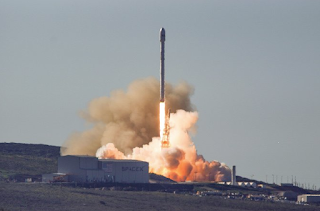Astronauts Gus Grissom (L), Ed White (C), and Roger Chaffee (R). Picture taken at Launch Complex 34, with the gantry tower in the background.
Hard to believe it was fifty years ago. On January 27, 1967, we lost three astronauts during a test of the newly-designed Apollo command module at the eventual launch site. It's a famous event, most of us remember reading about it. Mostly I remember having seen something on TV and having adults tell me what happened. Over the years I learned more and more of the mistakes that were made leading up to the moment of terror when an electrical arc from an exposed wire ignited the 100% oxygen in the test environment. The fire was quick and the intensity so hot and at such incredible pressure that it cracked the hull of the capsule and prevented immediate attempts to rescue the crew. But it was too late - the crew died firstly from the toxic fumes. Today I don't want to remember the scenes of the aftermath, there are plenty of sites on the Internet and a plethora of books describing it all. I like to picture them as they were before the fire, as shown above.
Above is an aerial view of LC-34. It was taken in 1963 during preparations for SA-4, a test launch of Saturn 1. You can see the twin gantry towers, which is the red tower complex seen in the first photo. A test Saturn rocket sits on the concrete pad base attached to the launch tower. The circular building is the launchpad protective firing room. It's obvious how close the pad was to the shoreline. Today it is all gone, except for the roads, concrete pads, the rocket launch base, and the firing room bunker.
The photo above is from my last trip to the Cape. This is the approach road to the complex on the western side. The concrete pads are out of sight to the right, while in the distance you can see launch towers from LC-37 ( still active launch site) on the left. You can visit the site if you take the Cape Canaveral AFB tour from the Kennedy Space Center visitors Center. This tour is only available during days when no rocket launches are planned, and I think only one tour a day is allowed.
The tour bus lets you off within walking distance of the launch pad base. The tower itself was scrapped years later, as were most of the facilities on old launch pads. It's actually quite a wide concrete base. There is a great feeling of quiet there except for the wind that blows towards the Atlantic just a short distance away.
This picture gives a greater sense of the size of the base related to human height. As you can see, weather and age are having its toll on the structure. There is some talk of tearing it down, but I would rather see some funds put into an effort to restore it. I would love to see NASA build a small building here to protect it from the elements and display in miniature how the pad looked and operated. To me, the pads are just as important as the rockets.
Next you can see the gigantic opening made for the flame exhaust from the mighty Saturn 1 engines. I believe the tubular ring is part of the fire suppression system to lesson the ground shock of the engine power. There is something symbolic in being able to look upwards towards space through this open portal.
These are the blast deflectors which would be placed under the rocket to deflect the fire and exhaust to a horizontal direction, avoiding a wave of pressure and flame from rebounding off the ground and damaging the engine section. These were not scrapped yet when I visited, and are stored at the edge of the giant pad. In the old picture of the pad, click it to enlarge it, and look behind the left side of the towers about midway up, and you can see on of these deflectors. That's where they still are.
From the launch tower base, you can look somewhat south and see the firing room bunker. In case of danger, the crew would be evacuated from the rocket, and taken up a long protected tunnel to the blast-resistant bunker. You can find it in the old complex photo very easily.
This is a view of the Firing room bunker as we drove past it in the bus. There was no stopping here, the bunker is off-limits to the tour. Our guide did not know if anything has been preserved inside the bunker. It was planned that the Saturn 1b rockets would launch from this pad complex, and the launch control room would have been in here. As it was, four Saturn 1 test launches were from here, and there were two Saturn 1B test launches from this pad before the Apollo 1 fire. Afterwards, the return of astronauts to space took place in the next manned launch, Apollo 7, from this complex. Operations then moved to the LC-39 complex.
When you walk under the launch base, you can feel history there. You sense the reverence and awe in the fellow visitors, and everyone whispers even though we are out in the open. This is part of our great space race past, and it is a place that deserves to be preserved and visited.














